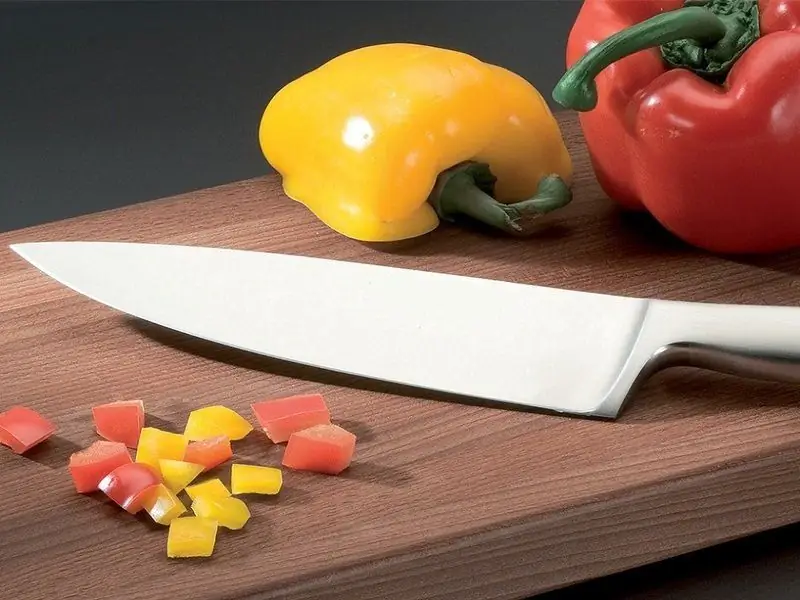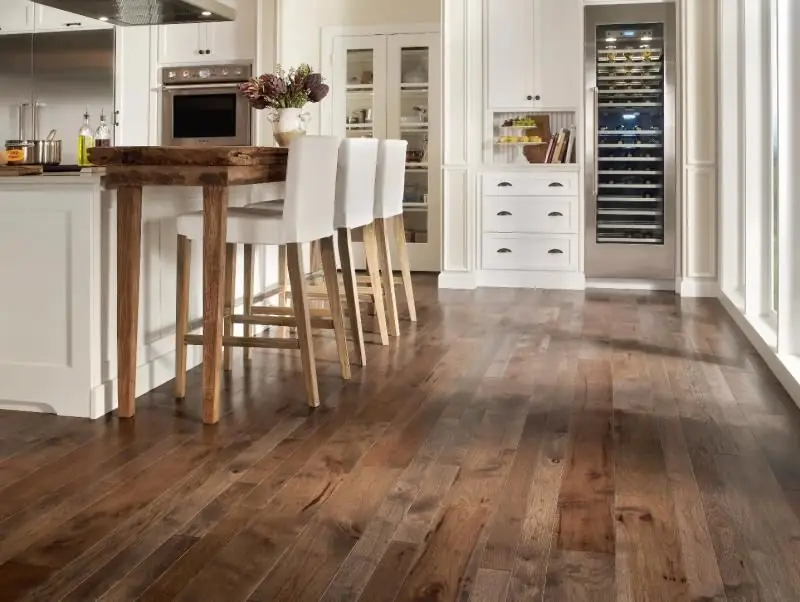
Table of contents:
- Author Bailey Albertson [email protected].
- Public 2023-12-17 12:53.
- Last modified 2025-01-23 12:41.
Materials for finishing the kitchen floor

The kitchen is a high-traffic room, therefore, the floor covering here must withstand increased loads - not only mechanical, but also temperature and food. Therefore, you need to choose a material that would meet all these requirements.
Content
-
1 Kitchen floor materials
- 1.1 Linoleum
- 1.2 Laminate
- 1.3 Wooden floor
- 1.4 Cork floor
-
1.5 Porcelain stoneware floor
1.5.1 Table: types of porcelain stoneware
- 1.6 Ceramic floor tiles
- 1.7 PVC tiles
- 1.8 Bamboo floor
- 1.9 Carpet
- 1.10 Concrete
- 1.11 Self-leveling floors
- 1.12 Combining floor coverings
- 1.13 Video: which coating is suitable for the kitchen
- 2 Which floor is better to make: design tips
Kitchen floor materials
Many materials are suitable for the kitchen, but you need to take into account the peculiarities of their operation.
Linoleum
Linoleum is the most commonly used kitchen decoration. Many owners choose this material because of its performance characteristics:
- resistance to abrasion, steam and moisture;
- ease of maintenance (linoleum can be safely cleaned using detergents);
- resistance to mechanical damage - if a heavy object falls on the floor, the appearance of a defect on the floor is unlikely.
The cost of linoleum is low, and you can lay it yourself, so repairs using this coating will be economical and practical.

Linoleum is a practical and inexpensive kitchen floor material.
Another advantage is the large selection of colors, textures and designs. In specialized stores, you can purchase a single-color coating or with imitation of tiles, marble, stone, metal and other expensive materials. For the kitchen, semi-commercial linoleum with a wear resistance class of 31 or 32 is best suited.
The only drawback of linoleum is dents caused by heavy objects on it for a long time. But if they do not move, then it will be possible to find out about the presence of dents only before changing the floor covering.
Laminate
Laminate is a chipboard or fiberboard dice covered with laminated paper with a pattern (the latter usually imitates a wood pattern, although there are options for marble, granite and other similar materials)
Laminate has the following strengths:
- low thermal conductivity;
- ease of care;
- ease of installation.
But before laying laminate flooring in the kitchen, you should think carefully - it has low resistance to moisture. Even a slight contact with water can lead to swelling of the material, and in this case restoration will be impossible, the entire coating will have to be changed.

Laminate flooring may swell from large amounts of water
Wooden floor
It can be parquet or wooden tiles. The latter resembles a tile in its appearance. Each of them can be different in shape and size, which allows you to make drawings on the floor.

Parquet is easy to scratch, so you need to put on special protective covers on the chair legs
A wooden kitchen floor must meet the following requirements:
- moisture resistance;
- high temperature resistance;
- ease of care;
- increased strength.
These characteristics are possessed by hardwood material. The best is oak parquet. If possible, it is recommended to purchase a thermal wood coating (aged at a high temperature), since such processing increases the strength of the wood - it will not warp, dry out, swell under the influence of moisture.
This material also has disadvantages:
- susceptibility to mechanical damage, for example, parquet can be easily scratched with stool legs or heels;
- if it is necessary to replace the dies after a long service life, it is not always possible to select the desired color and pattern, therefore, you need to immediately purchase material with a large margin;
- the need for careful care - many detergents cannot be used, moreover, the tree is capable of absorbing coloring liquids, after which stains remain on the floor.
For the kitchen, it is better to choose a parquet board that is soaked in oil rather than varnished, as this will minimize the risk of falling on a slippery floor.
Cork floor
Cork is not yet so popular among the owners of apartments and houses in our country. This is due to the presence of myths that the cork floor is fragile and deteriorates due to moisture. In fact, this is not the case. The cork floor will not swell or rot even if your neighbors flood you. There are other advantages to this material:
- softness;
- natural warmth;
- hypoallergenic;
- environmental friendliness (dirt does not accumulate and fungus does not multiply);
-
durability - there will be no dents or scratches on such a floor. Even if a heavy object falls on it, it will quickly regain its original shape.

Cork floor in the kitchen The cork floor does not rot or burn
There are several types of cork flooring:
- adhesive - is a two-layer (base - pressed cork, decorative coating - cork bark veneer) squares of 30 * 30, 45 * 45, 30 * 60 cm in size, a special adhesive is used for fastening. Some manufacturers produce beveled slabs that hide the joints;
- floating - is a fibreboard with two layers of cork, which are interconnected using the “thorn-groove” technology.
For the kitchen, it is preferable to choose adhesive tiles, since water can penetrate into the lock cracks. Some manufacturers produce plates with locks impregnated with moisture-resistant compounds. But they save only if a little water is spilled on the floor. In case of larger leaks, water will still get under the floor covering.
Has this coverage and disadvantages:
- high price;
- the risk of scratches, especially if a cat lives in an apartment with this floor (but there is always the opportunity to mask them with varnish).
Porcelain stoneware floor
Porcelain stoneware is an artificial stone. It is considered a synthetic material, although it contains natural ingredients. The base is quartz sand, kaolin and clay.

Porcelain stoneware is an artificially created stone from natural raw materials
The flooring material is square slabs with a smooth surface. Porcelain stoneware is suitable for the kitchen due to its advantages:
- high shockproof characteristics;
- moisture resistance (there are no air pores in the structure, which means that water will not penetrate into the plate itself);
- resistance to high temperatures, chemicals, food;
- the stability of the pattern even if small cracks appear on the tile, because the material is characterized by the through texture of the lines (the stone has the same pattern throughout its entire thickness).
All the advantages of porcelain stoneware are preserved only if the tiles are laid by professionals. This can be considered one of the disadvantages. There are others:
- long duration of preparatory and installation work;
-
cold surface.

Porcelain stoneware floor in the kitchen Porcelain stoneware is a durable but cold material
It is recommended to install matte porcelain tiles in the kitchen. It is worth choosing a material with the following characteristics:
- category PEI III, IV, V, which corresponds to coatings for premises with high traffic;
- abrasion resistance EN 122;
- flexural strength EN 100;
- class A and AA, which corresponds to floor coverings that do not change their appearance under the influence of an aggressive environment;
- caliber - the actual size (it is allowed to install a laminate of not one, but neighboring calibers, for example, a tile of caliber 0.8 goes well with a material of caliber 0.9, but it will be difficult to join tiles with a dimension of more than 2 mm).
Table: types of porcelain stoneware
| Material name | Color and texture | Color composition and finish | Cost characteristic |
| Monocolor type porcelain stoneware | Single color range, matte or glossy (polished) surface | Natural colors rarely found in nature | Business Class |
| Salt / pepper type | Solid color with splashes | Dye with the addition of synthetic materials | Economy class |
| Type "Granite" or other type of stone | Stylized color and texture like natural stone | Finishing using rare dyes of complex technologies | Premium class |
| Type "Marbled" | A marble surface of various colors is imitated | Finishing using complex dyes and technologies | Premium class |
| Textured porcelain stoneware | Any surface is simulated: wood, stone, and so on | Complex patterned drawing using high quality natural dyes | Premium class |
Floor ceramic tiles
Ceramic tiles are considered durable flooring materials ideal for kitchens. This is due to resistance to:
- household chemicals;
- abrasion;
- moisture;
- food products, including those containing acid.
Floor tiles allow you to decorate the interior of the kitchen in any style. For example, you can choose a tile that mimics expensive finishing materials.

Ceramic tiles are fragile, so you need to be careful with heavy objects in the kitchen
When finishing the kitchen floor, it is preferable to choose matte or embossed tiles. This will keep you from falling on wet floors.
When choosing ceramic tiles for the kitchen, it is worth considering all its disadvantages:
- fragility (during transportation or when a heavy object, especially metal, falls, there is a high probability of tile breakage);
- a cold surface, on which you cannot walk barefoot (arranging a warm floor will help to correct the situation);
- hardness (if the dishes fall on the floor, the coating will not be damaged, but the dishes themselves are unlikely to remain intact).
PVC tiles
Basically, PVC tiles are linoleum cut into squares. Therefore, the material has the same advantages, but there are others that are inherent in it:
- ease of installation due to the presence of an adhesive base;
- the ability to replace one tile if it is damaged, and not the entire floor;
-
the ability to combine tiles of different designs.

PVC tiles in the kitchen PVC tiles are cut linoleum, but with an adhesive surface
But when choosing, it is worth remembering the disadvantages:
- the presence of a large number of seams into which water easily penetrates;
- high risk of material swelling;
- susceptibility to mechanical damage, sunlight (fades in the sun);
- short service life.
Bamboo floor
A new type of flooring that is used in modern kitchens. They choose it for the following advantages:
- environmental safety, hypoallergenic;
- high strength and elasticity;
- wear resistance;
- decorativeness (bamboo floor has an original surface pattern, which is not typical for solid wood);
- ease of care.
The advantage of bamboo flooring can also be considered its cost, which is much lower than that of wood.

The bamboo floor has a limited number of colors
Among the disadvantages are:
- limited color range;
- susceptibility to deformation under the influence of moisture.
Carpet
Carpet is a pleasant to the touch flooring that is not suitable for use in the kitchen. This is due to the following features of the material:
- the complexity of cleaning (stains from fat, drinks, food are very difficult to remove, in most cases only dry cleaning can handle them);
- susceptibility to decay (when wet, the carpet dries for a long time, while creating good conditions for the growth of bacteria);
-
active accumulation of dust, which means that asthmatics should not even consider carpet as a floor covering.

Carpet on the floor Carpets take a long time to dry and may become stained
I have carpet throughout my apartment, because I like to move around the apartment barefoot. Therefore, the question of choosing a floor covering for the kitchen was especially acute for me. I found a way out of this situation. I chose porcelain stoneware for finishing the floor, and on top, in those places where my bare foot steps on the floor, I put pieces of carpet. I wash them every week in the machine and then dry them in the open air. There have been no problems with stains, dust and musty smell for three years.
Concrete
Concrete, with appropriate decorative treatment, can be an ideal floor covering for a kitchen. Its advantages include:
- moisture resistance;
- high temperature resistance;
- resistance to mechanical stress;
- long service life (concrete coating can be called almost eternal).
During the arrangement of the concrete screed, acid staining is used, so that you can easily change the color of the floor. This allows you to create a concrete floor imitating marble, slate, wood and other coatings.

The concrete floor has a long service life
The only drawback is that the floor will be cold if the heating system is not placed under it.
Self-leveling floors
For self-leveling floors, polyurethane or acrylic is used. These materials are characterized by:
- increased wear resistance;
- resistance to moisture (such a floor has no joints or cracks, there are no pores in the material, so water will not penetrate under the coating in any way);
- impact resistance;
- ease of care;
- aesthetics (you can make a floor with a 3D effect, emphasizing the overall design idea).
Unfortunately, these characteristics are combined with the high cost of such a floor and the installation time, which takes at least two weeks.

Self-leveling floor allows an endless variety of decor in the kitchen
Combining floor coverings
If you did not finally decide on the choice of flooring for the kitchen, then you can combine different materials. This will allow the zoning of the kitchen room. In this case, it is worth following the advice of professionals:
- for the working area it is worth choosing linoleum, PVC plates, ceramic tiles and porcelain stoneware;
- for the dining area, you can use carpet, cork, parquet.
Materials must be selected in such a way that they are most suitable for each other in thickness. If this is not possible, one part of the kitchen will have to be leveled with a screed, which will entail additional costs.

Only materials that have approximately the same thickness can be combined
Attention should be paid to the finishing of joints and transitions. Safety comes first, and aesthetics comes second. For this, you can use special strips, but they need to be mounted in such a way that a person does not stumble when moving from one zone to another.
Video: what kind of coating is suitable for the kitchen
Which floor is better to make: design tips
When choosing a floor covering for a kitchen, you need to pay attention not only to the practicality of the material, but also to decorativeness and compatibility with the style direction of the interior:
- large drawing and large elements visually reduce the room, therefore they are not suitable for small rooms;
- block parquet will help to visually enlarge the room, for this it must be laid by the deck method (intersection of the seams of one row of parquet with another, as well as a single contour of the parquet in all rooms);
- a glossy finish in the kitchen is undesirable, it is better to choose a matte finish;
- warm reddish and beige shades will help create extra comfort in the kitchen. Light colors visually expand the space, while dark ones, on the contrary, narrow it.
The choice of flooring also depends on the style of the interior:
- classic style allows the use of parquet, laminate, porcelain stoneware;
- provence or country - porcelain stoneware in a terracotta-dirty shade, aged parquet;
- hi-tech - linoleum, dark porcelain stoneware;
- retro - allows a combination of carpet and small-format tiles.
The choice of flooring for the kitchen determines not only the appearance of the room, but also the safety of the owners. Therefore, it is recommended to give preference to those materials that, when water gets on them, prevent falls and other injuries. The floor covering must be resistant to mechanical damage and moisture. Compliance with these requirements will allow not to repair the floors for a long time.
Recommended:
What To Make A Fence From: Which Is Better For A Summer Cottage, Principles And Tips For Choosing, Their Pros And Cons, Types, Purpose

Country fences have many varieties, it depends on the function, place and material. Which is better to put in a summer cottage and what can be made of
How To Choose A Kitchen Knife: Which Company Is Better And From Which Material

Rules for choosing knives for work in the kitchen. Types of knives, their distinctive qualities. Selection criteria, best manufacturers
Porcelain Stoneware Or Ceramic Tiles For The Floor In The Kitchen - Which Is Better, Comparative Characteristics, Expert Recommendations, Photo

Comparison of porcelain stoneware and ceramic tiles by the main parameters. Recommendations from experts on the choice of material for laying on the floor in the kitchen
How To Choose A Laminate For The Kitchen: Types, Pros And Cons, Recommendations, Reviews, Photos Before And After Installation

Advantages and disadvantages of laminate flooring in the kitchen, as well as the rules for choosing and maintaining flooring. Features of kitchen design with laminate
Android Or IPhone: Which Is Better And Why, Pros And Cons, Reviews

Which is better: Android or iPhone? The pros and cons of various devices. How to choose between these operating systems. Comparison with photos and consumer reviews
